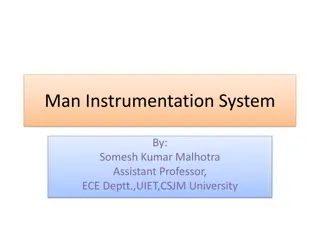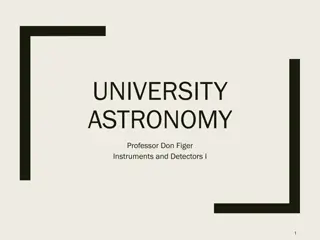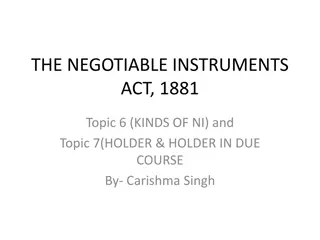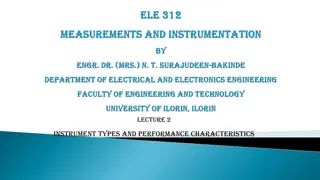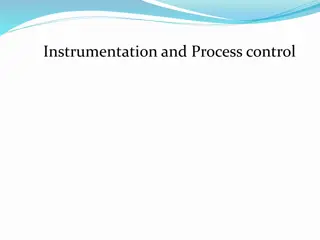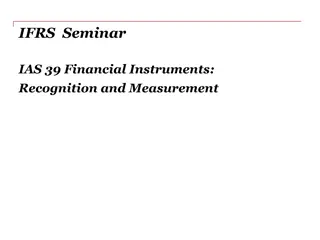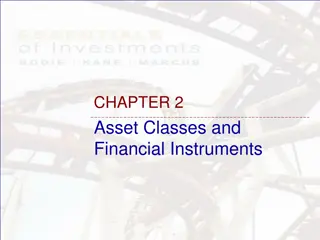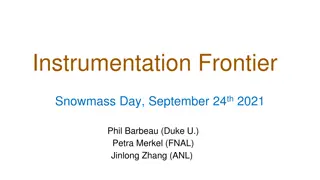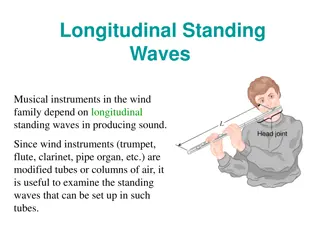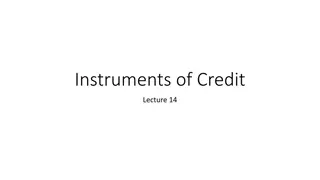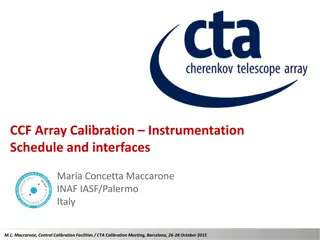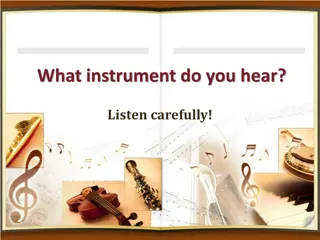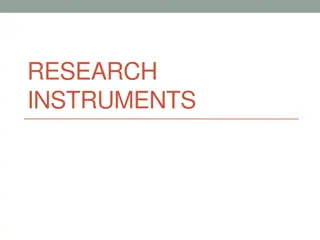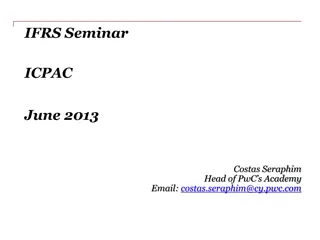Understanding Instruments in Instrumentation and Measurement
Passive and active instruments play key roles in measurement, with null-type and deflection-type instruments providing different ways to display values. Analogue and digital instruments offer varying outputs, while indicating instruments and those with signal outputs serve different purposes. Smart and non-smart instruments are distinguished by the presence of a microprocessor. Static characteristics, including accuracy and sensitivity, impact instrument selection for specific applications. Measurement uncertainty is a crucial aspect of instrument accuracy assessment.
Download Presentation

Please find below an Image/Link to download the presentation.
The content on the website is provided AS IS for your information and personal use only. It may not be sold, licensed, or shared on other websites without obtaining consent from the author. Download presentation by click this link. If you encounter any issues during the download, it is possible that the publisher has removed the file from their server.
E N D
Presentation Transcript
Instrumentationand Measurement Fall-1393 Instrument Types -Active and Passive Instruments Passive: instrumentoutput is producedentirelyby the quantitybeingmeasured Active: the quantitybeingmeasuredsimplymodulates themagnitudeof someexternalpower source -Null-Typeand Deflection-Type Instruments Deflectiontype: the value of the quantitybeingmeasuredis displayedin termsof the amountof movementof a pointer (like the pressuregauge) An alternativetype of pressuregaugeis the dead-weightgaugeshownin Figure,which is a null-type instrument.Here, weightsare puton topof thepiston untilthe downwardforcebalancesthe fluid 1
Instrumentationand Measurement Fall-1393 pressure.Weightsare added until the pistonreachesa datumlevel, known as thenull point.Pressure measurementis made in termsof the value of the weightsneededto reach thisnull position.A general rule that null-typeinstrumentsare more accuratethan deflectiontypes -Analogue and Digital Instruments Analogue: gives an output that varies continuously as the quantity being measured changes. The output can have an infinite number of values within the range that the instrument is designed to measure (the deflection-typeof pressuregauge) Digital:has an output thatvaries in discretestepsand so can only have a finite numberof values Analogueinstrumentsmustbe interfacedto themicrocomputerby an analogue-to-digital(A/D) converter,whichconvertsthe analogueoutputsignal from theinstrumentinto an equivalentdigital quantitythatcan be read into the computer. -Indicating Instruments and Instruments with a Signal Output Indicating:merelygive an audio or visual indicationof the magnitudeof the physicalquantity measured (normallyincludesall null-typeinstrumentsand mostpassive ones.Indicatorscan also be further divided intothosethathave an analogue output and thosethat have a digital display.A common analogue indicatoris the liquid-in-glass thermometer) With a Signal Output:give an outputin the form of a measurementsignalwhosemagnitudeis proportionalto the measuredquantity(commonlyas part of automaticcontrolsystems) 2
Instrumentationand Measurement Fall-1393 -Smart and Non-smart Instruments The adventof the microprocessorhas created a new divisionin instrumentsbetween thosethat do incorporatea microprocessor(smart)and those that don t A) Static Characteristics of Instruments If we havea thermometerin a room and its reading showsa temperatureof 20oC, then itdoes notreally matterwhetherthe true temperatureof theroom is 19.5 or 20.5oC. Such smallvariationsaround20oC are toosmall to affectwhether we feel warm enoughor not.Our bodiescannotdiscriminatebetween suchcloselevelsof temperatureand therefore a thermometerwith an inaccuracyof 0.5oC is perfectly adequate.If we hadto measurethe temperatureof certain chemicalprocesses,however,a variationof 0.5oC mighthave a significanteffecton the rate of reactionor even the productsof a process.A measurementinaccuracymuch less than 0.5oC is therefore clearly required. Accuracy of measurementis thusone considerationin the choiceof instrument fora particular application.Other parameters,suchas sensitivity,linearity,and the reaction to ambienttemperature changes,are furtherconsiderations.These attributes are collectivelyknown as the staticcharacteristics of instrumentsand are given in the datasheetfor a particularinstrument.It is importantto notethat values quoted for instrumentcharacteristicsin such a data sheetonly applywhen the instrumentis used under specifiedstandardcalibrationconditions. 1. Accuracy and Inaccuracy (Measurement Uncertainty) The accuracyof an instrument isa measureof how closethe outputreadingof the instrument isto the correctvalue. In practice,it is more usualto quotethe inaccuracy or measurementuncertaintyvalue rather thanthe accuracyvalue foran instrument.Inaccuracyor measurement uncertaintyis the extent to whicha reading might be wrong and is oftenquotedas a percentageof the full-scale(f.s.)reading of an instrument. The aforementionedexamplecarriesa very importantmessage.Because themaximum measurement error in an instrumentis usuallyrelated to the full-scalereadingof the instrument,measuringquantities thatare substantiallyless than the full-scalereadingmeansthatthe possiblemeasurementerror is amplified. Example A pressure gaugewitha measurementrange of 0 10 bar has a quotedinaccuracyof 1.0% f.s.( 1% of full-scalereading). (a) What is themaximummeasurementerror expected forthisinstrument?(b) What is the likely measurementerror expressedas a percentageof the outputreading if thispressure gauge is measuringa pressureof 1 bar? 3
Instrumentationand Measurement Fall-1393 2. Precision/Repeatability/Reproducibility Precisionis a term that describes an instrument sdegree of freedom from random errors. If a large numberof readingsare taken of the samequantity bya high- precisioninstrument,thenthe spread of readingswillbe very small.Precisionis often,althoughincorrectly, confusedwith accuracy. High precisiondoesnotimply anythingaboutmeasurement accuracy.A high-precision instrumentmay have a lowaccuracy.Low accuracy measurementsfrom a high-precision instrumentare normallycausedby a bias in themeasurements,which is removableby recalibration. 3. Tolerance Tolerance is a term thatis closelyrelatedto accuracyand defines themaximumerror that isto be expectedin somevalue. Whileit is not,strictlyspeaking,a staticcharacteristicof measuring instruments,it is mentionedhere becausethe accuracy of someinstrumentsis sometimesquotedas a tolerancevalue. When used correctly,tolerance describesthe maximumdeviationof a manufactured componentfromsomespecifiedvalue. 4. Range or Span The range or spanof an instrumentdefinesthe minimumand maximumvalues of a quantitythatthe instrumentis designedto measure. 4
Instrumentationand Measurement Fall-1393 5. Linearity It is normally desirable that the output readingof an instrument is linearly proportional to the quantitybeing measured. The Xs marked on Figure 2.6 show a plot of typical output readings of an instrument when a sequence of input quantities are applied to it. Normal procedure is to draw a good fit straight line through the Xs, as shown in Figure 2.6. Nonlinearityis then defined as the maximum deviation of any of the output readings marked X from this straight line. 6. Sensitivity of Measurement The sensitivityof measurementis a measureof the changein instrumentoutputthatoccurs when the quantitybeingmeasured changesby a given amount.Thus,sensitivityis the ratio: The sensitivityof measurementis therefore the slopeof the straightline drawn on Figure 2.6. 7. Threshold If the input to an instrumentis increasedgraduallyfrom zero, theinput will have to reach a certain minimum level beforethe changein the instrumentoutputreading is of a large enough magnitudeto be detectable.Thisminimumlevel of input is known as the thresholdof the instrument.Manufacturers vary in the way thatthey specifythresholdfor instruments.Somequoteabsolutevalues,whereas others quotethresholdas a percentageof full-scalereadings. 8. Resolution When an instrumentis showinga particularoutputreading, there is a lowerlimiton the magnitudeof the change in the inputmeasuredquantitythat producesan observablechange in the instrument 5
Instrumentationand Measurement Fall-1393 output.Like threshold,resolutionis sometimesspecifiedas an absolute value and sometimesas a percentageof f.s. deflection.One of themajor factorsinfluencing the resolutionof an instrumentis how finely itsoutputscaleis divided into subdivisions. 9. Sensitivity to Disturbance All calibrationsand specificationsof an instrumentare onlyvalid undercontrolledconditionsof temperature,pressure,and so on. Thesestandardambientconditions areusuallydefined in the instrumentspecification.As variationsoccurin the ambienttemperature,certainstaticinstrument characteristicschange,and the sensitivityto disturbanceis a measureof the magnitudeof thischange. Figure2.7 Example The followingtable showsoutputmeasurementsof avoltmeterunder two setsof conditions:(a) Use in an environment keptat 20oC whichis the temperaturethat itwas calibratedat. (b) Use in an environmentata temperatureof 50oC. 6
Instrumentationand Measurement Fall-1393 Determine thezero driftwhen it is used in the 50oC environment,assumingthatthe measurement values when it wasused in the 20oC environmentare correct.Also calculatethe zero driftcoefficient. 10.HysteresisEffects If the inputmeasured quantity tothe instrumentis increasedsteadilyfrom a negativevalue, the outputreading varies in themanner shownin curve A. If the input variable is then decreasedsteadily, the output varies in the manner shownin curve B. The non-coincidencebetween these loading and unloadingcurvesis knownas hysteresis. Hysteresisis foundmostcommonlyin instruments thatcontainsprings,when frictionforces in a systemhave different magnitudesdependingon the directionof movement,or in instrumentsthatcontain electricalwindingsformedroundan iron core,due tomagnetichysteresis in the iron. 11.Dead Space Dead spaceis definedas the range of different inputvalues over whichthere is no changein output value. Any instrumentthatexhibitshysteresisalso displaysdead space. Someinstrumentsthatdo not sufferfrom any significanthysteresiscan stillexhibita dead spacein theiroutputcharacteristics, however.Backlashin gearsis a typicalcauseof deadspace and results in the sortof instrumentoutput characteristicshownin Figure below.Backlashis commonlyexperiencedin gear setsused to convert betweentranslationaland rotationalmotion. 7
Instrumentationand Measurement Fall-1393 B) Dynamic Characteristics of Instruments The staticcharacteristicsof measuring instruments areconcernedonly withthe steady-statereading thatthe instrumentsettlesdownto, suchas accuracyof thereading. The dynamiccharacteristicsof a measuringinstrumentdescribe its behaviorbetweenthe timea measuredquantitychangesvalue and the timewhen the instrument outputattainsa steadyvalue in response. In any linear,time-invariantmeasuringsystem,the followinggeneral relation can be writtenbetween input and outputfor time(t) > 0: (2.1) Where qiisthe measuredquantity, qois the outputreading, and ao. . . an, bo. . . bmare constants. If we limitconsiderationto thatof step changes inthe measured quantityonly, then Equation(2.1) reduces to: (2.2) Further simplificationcan be made by takingcertainspecial casesof Equation(2.2), whichcollectively apply to nearlyall measurementsystems. 8
Instrumentationand Measurement Fall-1393 1. Zero-Order Instrument If all thecoefficientsa1. . . another than a0in Equation(2.2) are assumedzero, then: where K is a constantknown as the instrumentsensitivityas defined earlier. Any instrumentthatbehavesaccordingto Equation(2.3) is saidto be of a zero-order type. Followinga stepchange inthe measuredquantityat timet, the instrumentoutputmoves immediately to a newvalue at the sametime instantt, as shown in Figure below.A potentiometer,whichmeasures motion,is a goodexampleof suchan instrument,where the outputvoltagechangesinstantaneouslyas the slider is displacedalongthe potentiometertrack. 2. First-Order Instrument If all the coefficients a2. . . an except for aoand a1are assumed zero in Equation (2.2) then Any instrument that behaves according to Equation (2.4) is known as a first-order instrument. If d/dt is replaced by the D operator in Equation (2.4), we get: 9
Instrumentationand Measurement Fall-1393 If Equation (2.6) is solved analytically, the output quantity q0in response to a step change in qiat time t varies with time in the manner shown in Figure below. The time constant of the step response is time taken for the output quantity q0to reach 63% of its final value. The thermocouple is a good example of a first-order instrument. A large numberof otherinstrumentsalso belongto thisfirst-order class:thisis of particularimportance in controlsystemswhere itis necessary to take accountof the timelag thatoccurs betweena measured quantitychangingin value and the measuringinstrumentindicating the change.Fortunately,because the timeconstantof manyfirst-orderinstruments issmall relative to the dynamicsof the processbeing measured, no seriousproblemsare created. Example A balloonis equipped withtemperatureand altitudemeasuringinstrumentsand has radio equipment thatcan transmittheoutputreadings of these instrumentsbackto ground.Theballoonis initially anchoredto the ground withthe instrumentoutput readingsin steadystate.The altitude-measuring instrumentis approximatelyzero order and the temperature transducerfirstorder with a timeconstant 10
Instrumentationand Measurement Fall-1393 of 15 seconds.The temperatureon the ground, T0, is 10 C and the temperatureTxat an altitudeof x metresis givenby the relation: TxD T0- 0.01x (a)If the balloonis released at time zero, and thereafterrises upwardsat a velocityof 5 metres/second, draw a table showingthe temperatureand altitudemeasurementsreportedat intervalsof 10 seconds over the first50 secondsof travel. Show also in the table theerror in eachtemperaturereading. (b) Whattemperaturedoesthe balloonreport at an altitudeof 5000 metres? 3. Second-Order Instrument If all coefficientsa3. . . anotherthan a0, a1, and a2in Equation(2.2) are assumedzero, then we get: It is convenientto re-expressthevariablesa0, a1, a2, and b0 in Equation(2.8) in termsof three parameters:K (staticsensitivity), (undampednatural frequency),and (dampingratio),where: 11
Instrumentationand Measurement Fall-1393 This is the standardequationfor a second-ordersystem,and any instrumentwhoseresponsecan be described byit is known as a second-orderinstrument.If Equation(2.9) is solvedanalytically, theshape of thestep responseobtained dependson the valueof the damping ratioparameter x. Theoutput responsesof a second-orderinstrument forvariousvalues of x followinga stepchange in thevalue of the measuredquantityat time t are shownin Figure below. References: -Measurementand instrumentation:theoryand application/ Alan S. Morris; Reza Langari, 2012 12



